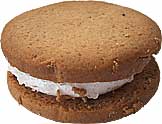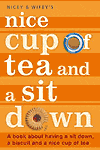Your ViewsKeep your e-mails pouring in, it's good to know that there are lots of you out there with views and opinions. To help you work out what is what, are now little icons to help you see biscuit related themes. And now you can see at a glance which are the most contested subjects via this graph (requires Flash 6.0 plugin). Please keep your mails coming in to nicey@nicecupofteaandasitdown.com | If you like, you can use this search thingy to find stuff that matches with any of the icons you pick, or use the fantastic free text search, Yay! | Your e-Mails |
Lindsey Dodd

Kimberley and Chocolate Kimberley Review |
Dear Nicey
I was interested to note the recent emails concerning our Russian cousins' drinking of tea with jam, and would like to tell Nicky Bramley about my Polish experience: one of the jams of choice which was added to tea in that fine country, by my unfine fellow-at-the-time, was rose jam. It had petals and everything (when I say 'everything' I exclude thorns and hips and leaves and stalks and roots). Rose jam is also a popular choice in Poland's famous doughnuts, which are merrily scoffed in a pre-Lenten fashion (a la pancakes), as is cheese. But that is another - and quite dangerous - matter. Imagine those petals floating up in your tea! Very pretty.
Best regards,
Lindsey.
PS I am currently downing vats of tea (milked, not jammed) in order to rid my mouth of the unpleasant sensation of a Jacobs Kimberley. How can these atrocities be permitted in this day and age?
|
| |
| Nicky Bramley |
Wow, I’d love to know what type of jam is used in Russian tea.
Strawberry? Lumps of strawberry hunkered at the bottom of the cup
Raspberry? A layer of pips to sieve through your teeth when you get to the bottom
Rhubarb? Stringy floaters
Blackcurrant? Little bouncy purple balls popping to the surface from time to time
Aren’t other countries wonderful?
Nicky |
| Nicey replies: Yes it does raise many questions, doesn't it? |
| |
| Isabel Stainsby |
Dear Nicey,
I'm glad that you have decent jam at NCOTAASD HQ - this means you can try drinking tea Russian style. I lived in Russia a few years ago and when I first came across tea-with-jam, I thought "Yuck!" - until I tried it. It's easy to make - make ordinary black tea the way you like it best, then stir in a generous teaspoonful of good-quality, preferably home-made jam. Don't add milk, and obviously you won't need sugar.
Incidentally, the Russians don't always drink tea like this, just when they have people round for tea. The jam (in Russian, varenie) is provided in bowls and people also put it on slices of bread - and it's always home-made and extremely nice.
I do hope you like this new tea-drinking experience. I'm going to go and eat some biscuits now.
Isabel
|
| Nicey replies: That is so much more impressive than fruit tea. |
| |
| Liz Whiting |
Dear Nicey
I have recently started a new job where my tea-drinking and biscuit-eating is oft derided and little understood. I am however recognised as a bit of a caffeine and cake buff, obviously due in great part to knowledge gleaned from your fabulous site. But I cannot answer a question from a certain young lad named Jimmy, who wishes to know what process tea goes through when it is decaffeinated, and whether it is truly safe to sip a decaffeinated brew, or if it's stuffed full of extra chemicals and whatnot. If your readers and you might be able to throw light on this knotty issue, I'd be ever so grateful, and my reputation as Queen of Tea might just remain intact.
With everlasting admiration
Lizzie |
| Nicey replies: Well we were as much in the dark about this as you, we sort of knew solvents were involved. So we asked the people who know the Tea Council, and received this very helpful reply from Bill
There are three methods used to wash caffeine out of tea, but number one of the following list is most commonly used.
- Di Choloromethylene (organic solvent)
- Ethyl Acetate (organic solvent)
- Super Critical Co2 (high temperature / under pressure)
All methods are governed by legal limits and of course you never get absolutely all caffeine out. There is always a residue but the industry works to a standard of 0.02g / 100g
Towards the end of the production process (about forty minutes in) but before drying, the tea is washed in an organic solvent (this procedure is common to all products that are decaffeinated) and after washing is sent to the dryer.
The entire industry takes great care to ensure that solvent residues are at fractional levels in the dry leaf when the process is completed. Every production run is rigorously tested for solvent and caffeine residues and those levels are governed by law. Extensive testing has shown that any fractional solvent residue found in the dry leaf evaporates as the scalding water is introduced to the decaffeinated tea.
I hope this helps.
Kind regards
Bill Gorman |
| |
| Mike Armitage |
Hello Nicey ,Wifey and the rest of the team.
I've just come back from a cycling holiday in Oakham, Rutland. I visited the local market while I was there and found a specialist Tea stall. ( Must be because the Oakham School is quite posh!) There were 3 varieties of Earl Grey tea on this stall! I bought some loose tea, a tea caddy and a "Dauerfilter" for making loose tea directly in the cup. Its a permanent filter and is "Auch ideal zum Aufbruhen von kaffee"
I don't remember which variety of Earl grey tea I bought because the stall owner put it directly in my new caddy but it has a very strong scent of bergamot and it quite delicious.
I have been amazed by people far and wide who admit to having seen and enjoyed your site or have read your book.
Mike Armitage |
| Nicey replies: We keep passing through Rutland, and Oakham on our way to and from other places. In fact we tried to find somewhere to camp up there two weeks ago but wound up in Derbyshire. If we had of made it to Rutland we would have been cycling round there too..
Just got back from a splendid bike ride this afternoon with both younger members of staff and Nanny Nicey. All off road in the hills between Saffron Walden and Royston. We took half a home made fruit cake and a flask of tea. We pop two teabags in the flask when we are ready to make the tea, and this works very well indeed. |
| |
|
|
|




